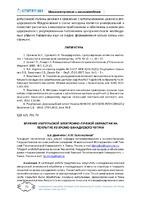Влияние импульсной электронно‐лучевой обработки на покрытие из хромо‐ванадиевого чугуна

Ver/
Fecha
2015Autor
Дампилон, Б. В.
Толстокулаков, А. М.
Metadatos
Mostrar el registro completo del ítemResumen
В настоящей работе представлены результаты исследования влияния импульсной электронной обработки и последующего отжига на структуру и твердость покрытий из хромо‐ванадиевого чугуна. Покрытия были получены методом электроннолучевой наплавки на подложке из малоуглеродистой стали. После шлифования поверхности покрытий были обработаны локально импульсным сфокусированным в точку электронным пучком. Результаты исследования показали, что модифицированные зоны состоят из двух фаз. Первая фаза – пересыщенный аустенит. Вторая локально распределенные в объеме модифицированной зоны зародыши эвтектики. Результаты измерений системой NanoTest показали, что модифицированные зоны имеют низкие значения твердости. Низкие значения твердости, вероятно, обусловлено наличием значительного объема пересыщенного аустенита в модифицированной зоне. Отжиг приводит к значительному увеличению твердости модифицированных зон. В результате отжига (500ᴼC) пересыщенный аустенит распадается. Повышение температуры отжига до 1100ᴼC приводит к росту и коагуляции карбидной фазы модифицированных зон. Results of investigation of effect of impulsive electron‐beam processing and following annealing on structure and hardness of hardfaced chrome‐vanadium cast iron coatings are presented in given paper. The coatings were obtained by electron‐beam hardfacing on low‐carbon steel substrates. After grinding surfaces of the coatings were locally processed by impulsive focused electron beam with discrete point distribution in a square packing on the surface area. The research results showed that the modified zones consist of two phases. The first phase is supersaturated austenite. The second phase locally distributed in the volume of modified zone is the nucleation centers of eutectic. Results of measuring by NanoTest system showed that modified zones have low values of hardness. Low hardness values are probably caused by presence of significant volume of supersaturated austenite in modified zone. Following annealing of specimens led to significant increasing of hardness of modified zones. As a result of the annealing (500ᴼC) supersaturated austenite is decomposed on eutectoid with nanoscale structure components. Increasing of the annealing temperature up to 1100ᴼC results in decomposition of supersaturated austenite, growth and coagulation of carbide phase in the modified zones.
